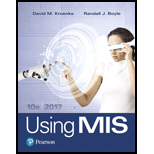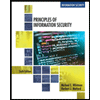
Using MIS (10th Edition)
10th Edition
ISBN: 9780134606996
Author: David M. Kroenke, Randall J. Boyle
Publisher: PEARSON
expand_more
expand_more
format_list_bulleted
Expert Solution & Answer
Chapter 8.8, Problem 3SGDQ
Explanation of Solution
Normal deletion of file:
“No”, normal deletion of files can’t permanently remove the file from the memory of the device. Perceptible device represents a medium by which privacy can be disturbed.
- When the users delete a file on a computer then that file is not permanently erased, but in reality, the computer simply deletes the file on the hard drive but it actually remains.
- Deleting files and marking its space as available is an extremely fast operation.
- To improve the system performance and save time, the
operating systems do not erase a file’s contents when it’s deleted. - The deleted files are temporarily stored in the recycle bin or trash folder. If the user does not want that file, then he or she permanently clears the recycle bin or trash folder, but it actually stores it in a hard drive.
Recover the deleted file:
“Yes”, the files can be recovered after deleting them. There are three possible way to recover deleted files...
Expert Solution & Answer
Want to see the full answer?
Check out a sample textbook solution
Students have asked these similar questions
In three years, assuming the competitive environment remains unchanged, how many units of Bat will Baldwin be selling in the Nano market segment?
a) 639
b) 561
c) 431
d) 716
Brand managers know that increasing promotional budgets eventually result in diminishing returns. The first one million dollars typically results in a 26% increase in awareness, while the second million results in adding another 18% and the third million in a 5% increase. Andrews’s product Alan currently has an awareness level of 80% . While an important product for Andrews, Alan’s promotion budget will be reduced to one million dollars for the upcoming year. Assuming that Alan loses one-third of its awareness each year, what will Alan’s awareness level be next year?
a) 79%
b) 53%
c) 74%
d) 58%
Do not use A.I and solve completely
Chapter 8 Solutions
Using MIS (10th Edition)
Ch. 8.3 - Prob. 1EGFQCh. 8.3 - Prob. 2EGFQCh. 8.3 - Prob. 3EGFQCh. 8.3 - Prob. 4EGFQCh. 8.4 - Prob. 1EGDQCh. 8.4 - Prob. 2EGDQCh. 8.4 - Prob. 3EGDQCh. 8.4 - Prob. 4EGDQCh. 8.4 - Prob. 5EGDQCh. 8.8 - Prob. 1SGDQ
Ch. 8.8 - Prob. 2SGDQCh. 8.8 - Prob. 3SGDQCh. 8.8 - Prob. 4SGDQCh. 8.8 - Prob. 8.1ARQCh. 8.8 - Prob. 8.2ARQCh. 8.8 - Prob. 8.3ARQCh. 8.8 - Prob. 8.4ARQCh. 8.8 - Prob. 8.5ARQCh. 8.8 - Prob. 8.6ARQCh. 8.8 - Prob. 8.7ARQCh. 8.8 - Prob. 8.8ARQCh. 8 - Prob. 8.1UYKCh. 8 - Prob. 8.2UYKCh. 8 - Prob. 8.3UYKCh. 8 - Prob. 8.4UYKCh. 8 - Prob. 8.5UYKCh. 8 - Prob. 8.6CE8Ch. 8 - Prob. 8.7CE8Ch. 8 - Prob. 8.1CS8Ch. 8 - Prob. 8.11CS8Ch. 8 - Prob. 8.12CS8Ch. 8 - Prob. 8.13CS8Ch. 8 - Prob. 8.14CS8Ch. 8 - Prob. 8.15CS8Ch. 8 - Using your answers to these questions, write a job...Ch. 8 - Prob. 8.17CS8Ch. 8 - Prob. 8.18MMLCh. 8 - Prob. 8.19MML
Knowledge Booster
Similar questions
- Solve thisarrow_forwardSpecifications: Part-1Part-1: DescriptionIn this part of the lab you will build a single operation ALU. This ALU will implement a bitwise left rotation. Forthis lab assignment you are not allowed to use Digital's Arithmetic components.IF YOU ARE FOUND USING THEM, YOU WILL RECEIVE A ZERO FOR LAB2!The ALU you will be implementing consists of two 4-bit inputs (named inA and inB) and one 4-bit output (named out). Your ALU must rotate the bits in inA by the amount given by inB (i.e. 0-15).Part-1: User InterfaceYou are provided an interface file lab2_part1.dig; start Part-1 from this file.NOTE: You are not permitted to edit the content inside the dotted lines rectangle.Part-1: ExampleIn the figure above, the input values that we have selected to test are inA = {inA_3, inA_2, inA_1, inA_0} = {0, 1, 0,0} and inB = {inB_3, inB_2, inB_1, inB_0} = {0, 0, 1, 0}. Therefore, we must rotate the bus 0100 bitwise left by00102, or 2 in base 10, to get {0, 0, 0, 1}. Please note that a rotation left is…arrow_forwardHow can I perform Laplace Transformation when using integration based on this? Where we convert time-based domain to frequency domainarrow_forward
- what would be the best way I can explain the bevhoirs of Laplace and Inverse Transofrmation In MATLAB.arrow_forwardWhat IETF protocol is NetFlow associated with? Group of answer choices IPX/SPX IPIX HTTPS SSHarrow_forwardHow can I perform Laplace Transformation when using integration based on this?arrow_forward
- Write an example of a personal reflection of your course. - What you liked about the course. - What you didn’t like about the course. - Suggestions for improvement. Course: Information and Decision Sciences (IDS) The Reflection Paper should be 1 or 2 pages in length.arrow_forwardHow can I perform Laplace Transformation when using integration ?arrow_forwardUsing R languagearrow_forward
arrow_back_ios
SEE MORE QUESTIONS
arrow_forward_ios
Recommended textbooks for you
 A+ Guide To It Technical SupportComputer ScienceISBN:9780357108291Author:ANDREWS, Jean.Publisher:Cengage,
A+ Guide To It Technical SupportComputer ScienceISBN:9780357108291Author:ANDREWS, Jean.Publisher:Cengage, Enhanced Discovering Computers 2017 (Shelly Cashm...Computer ScienceISBN:9781305657458Author:Misty E. Vermaat, Susan L. Sebok, Steven M. Freund, Mark Frydenberg, Jennifer T. CampbellPublisher:Cengage Learning
Enhanced Discovering Computers 2017 (Shelly Cashm...Computer ScienceISBN:9781305657458Author:Misty E. Vermaat, Susan L. Sebok, Steven M. Freund, Mark Frydenberg, Jennifer T. CampbellPublisher:Cengage Learning Systems ArchitectureComputer ScienceISBN:9781305080195Author:Stephen D. BurdPublisher:Cengage Learning
Systems ArchitectureComputer ScienceISBN:9781305080195Author:Stephen D. BurdPublisher:Cengage Learning Principles of Information Systems (MindTap Course...Computer ScienceISBN:9781285867168Author:Ralph Stair, George ReynoldsPublisher:Cengage Learning
Principles of Information Systems (MindTap Course...Computer ScienceISBN:9781285867168Author:Ralph Stair, George ReynoldsPublisher:Cengage Learning Principles of Information Security (MindTap Cours...Computer ScienceISBN:9781337102063Author:Michael E. Whitman, Herbert J. MattordPublisher:Cengage Learning
Principles of Information Security (MindTap Cours...Computer ScienceISBN:9781337102063Author:Michael E. Whitman, Herbert J. MattordPublisher:Cengage Learning

A+ Guide To It Technical Support
Computer Science
ISBN:9780357108291
Author:ANDREWS, Jean.
Publisher:Cengage,

Enhanced Discovering Computers 2017 (Shelly Cashm...
Computer Science
ISBN:9781305657458
Author:Misty E. Vermaat, Susan L. Sebok, Steven M. Freund, Mark Frydenberg, Jennifer T. Campbell
Publisher:Cengage Learning

Systems Architecture
Computer Science
ISBN:9781305080195
Author:Stephen D. Burd
Publisher:Cengage Learning


Principles of Information Systems (MindTap Course...
Computer Science
ISBN:9781285867168
Author:Ralph Stair, George Reynolds
Publisher:Cengage Learning

Principles of Information Security (MindTap Cours...
Computer Science
ISBN:9781337102063
Author:Michael E. Whitman, Herbert J. Mattord
Publisher:Cengage Learning